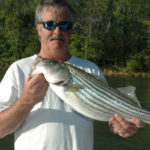
Fish are on the move as summer arrives, but you can follow them
Summer is just around the corner, but fishing for stripers and hybrids is already heating up on Lake Hartwell, according to guide Chip Hamilton of Piedmont.
Water temperature is the key, he said, with action up the lake in pockets and coves and down the lake in deeper water — plus, sporadic schooling can fill a cooler in a short time.
“Early June is almost always a carryover of the dominant May pattern,” said Hamilton (864-304-9011). “The fish that are still up the river arms are usually holding near the channel near creek junctions or at the mouths of deep coves. They won’t be far from deep water and can be caught in 35 to 40 feet of water by dropping Carolina-rigged herring right on top of them.”
But as the month progresses, fish will move into deeper water, and two patterns will develop, he said.
“Nothing really dictates which pattern will be productive on a given day. You’ve just got to look for the fish,” Hamilton said.
One of the patterns is in the 45- to 50-foot range over a clean bottom. The other is fishing in 60 to 100 feet of water just over the submerged treetops that line Hartwell’s basin, he said.
“The majority of the trees were topped so they would be 30 feet below the surface at full pool,” Hamilton said. “The typical pattern is to fish the live herring 26 to 28 feet deep right over the tops of those trees.”
That can be exciting — and hazardous to your tackle, he said.
“When a fish comes up out of the trees to bite, you’ve got a decision to make. When you hook a hybrid, they almost always stay down, so you want to use at least 20-pound line to keep them out of the trees. But if you hook a really nice striper, one in the teens and up, you are at his mercy. If he runs out, which a striper normally does, you are okay. But if he runs down, you have a problem.”
Those are the two main patterns, Hamilton said, but a third pattern can provide some of the best action of the year: schooling.
“Schooling in June, while unpredictable, can be absolutely dynamic,” he said. “You might start out at daylight and catch a few fish in a cove, and then they might explode. You can cast your favorite topwater or throw a free-lined herring at them. They’ll hit anything that moves.”
The catch from schooling fish may include both stripers and hybrids, he said, plus an exciting bonus species: big spotted bass, which will mix in with the other fish in the school.
There is one more pattern that comes into play later in the month, Hamilton said.
“Towards the end of June, the deep-water, night- fishing pattern will start. Some guys get out on the main Savannah River channel and in the mouths of the Tugaloo and Seneca rivers, with a sodium light and fish for stripers and hybrids at night,” he said. “The key is to set up before dark and have the light out early so it will draw the bait in quickly once the sun goes down.”



Be the first to comment